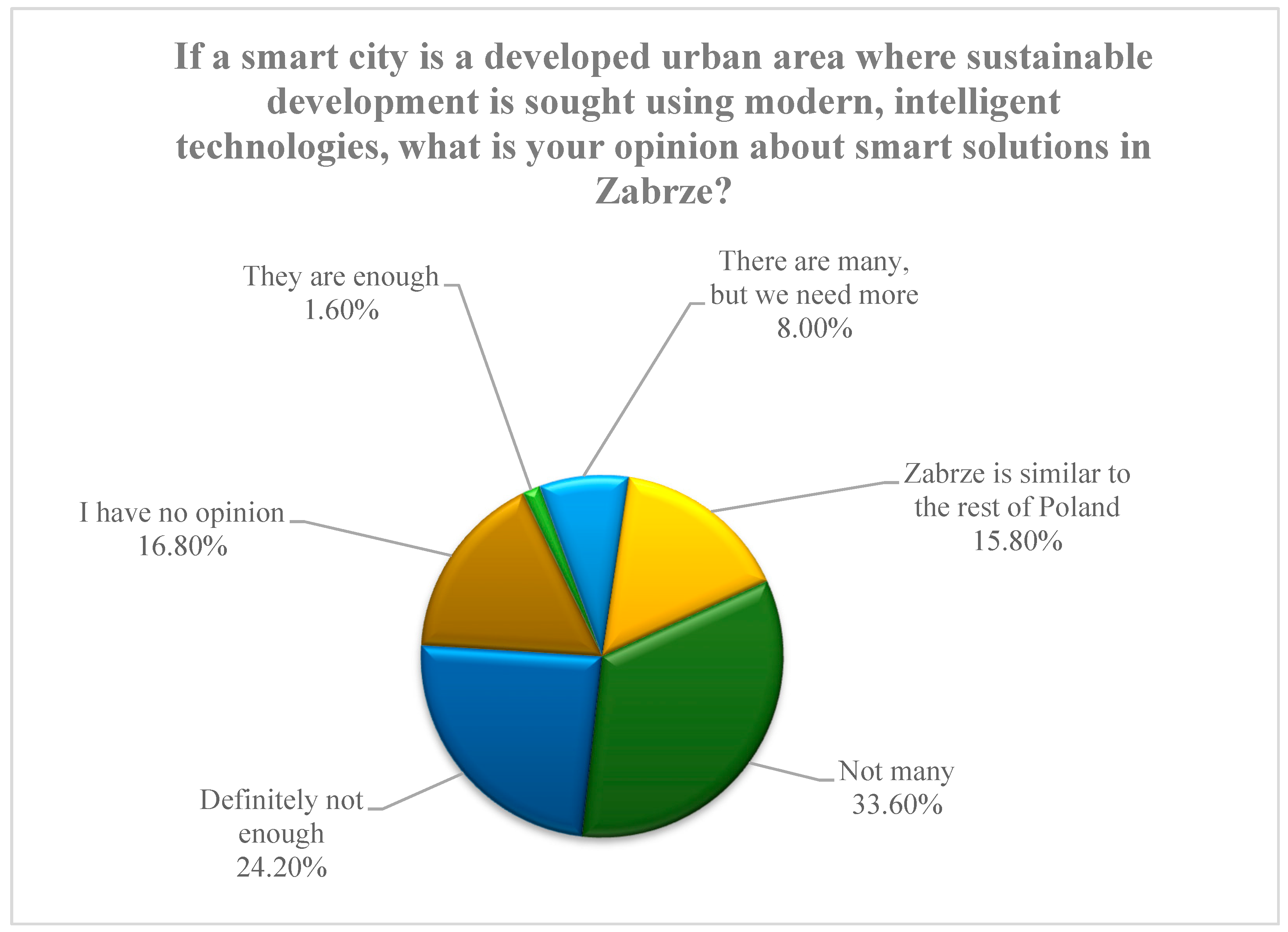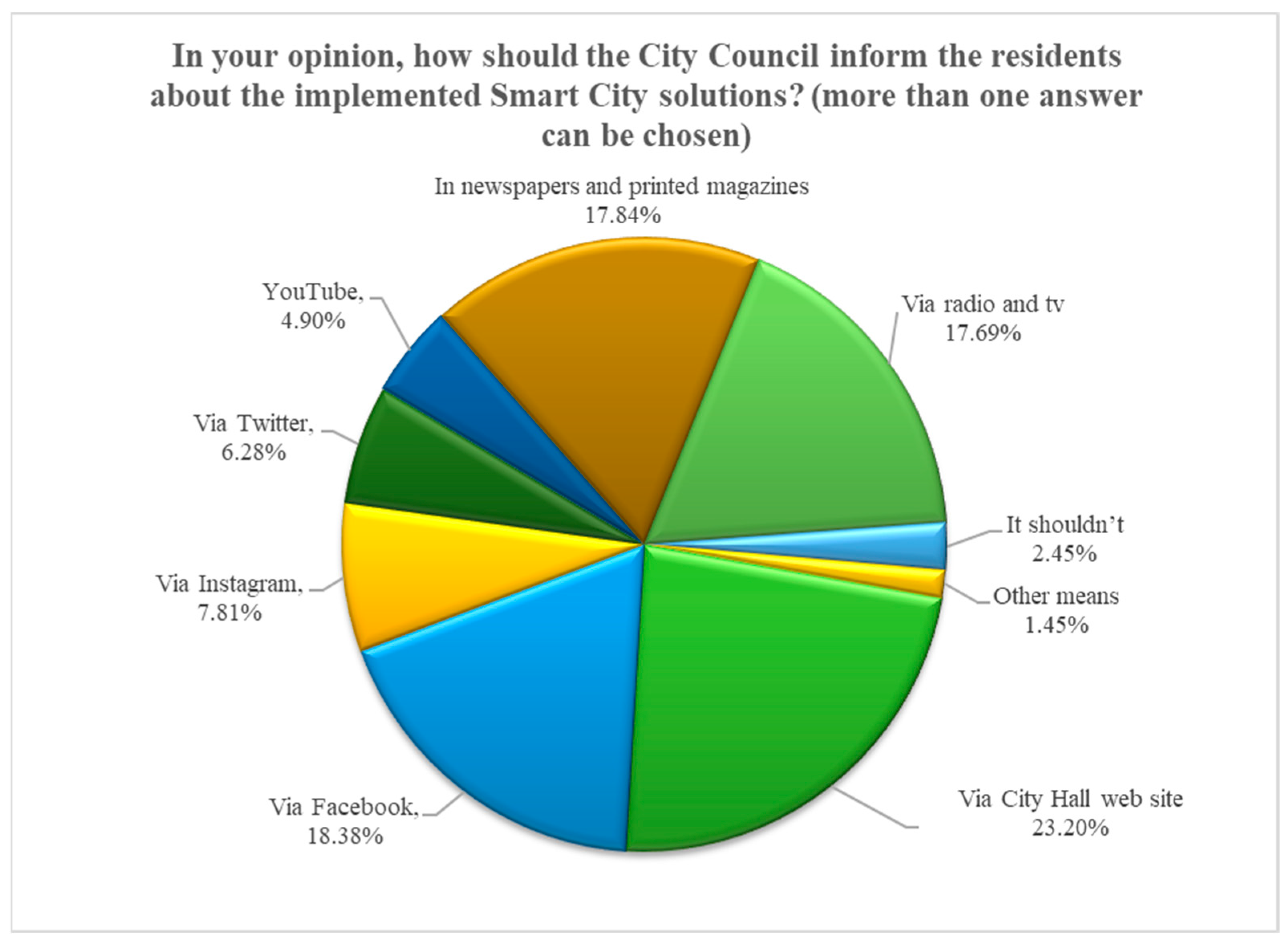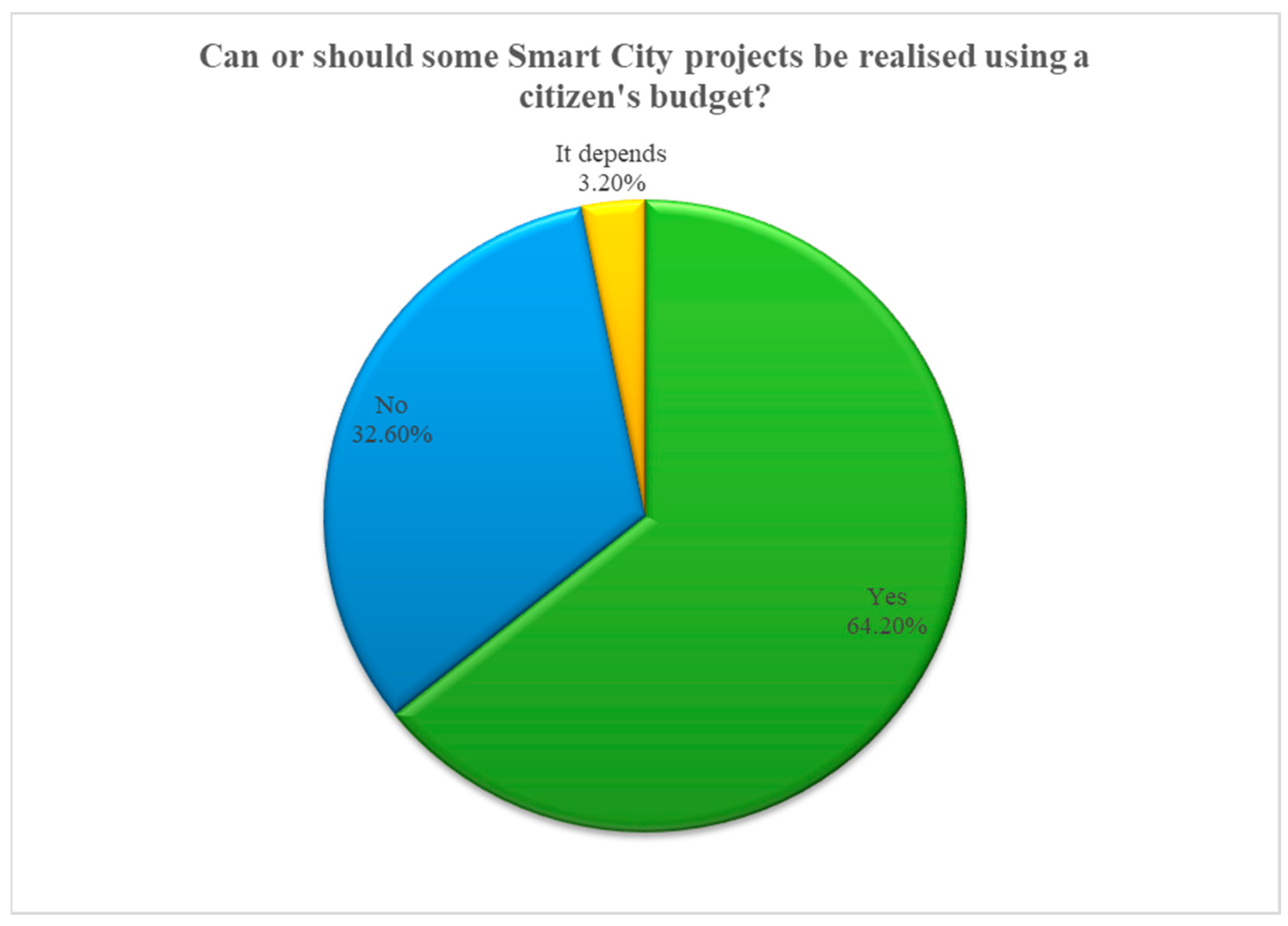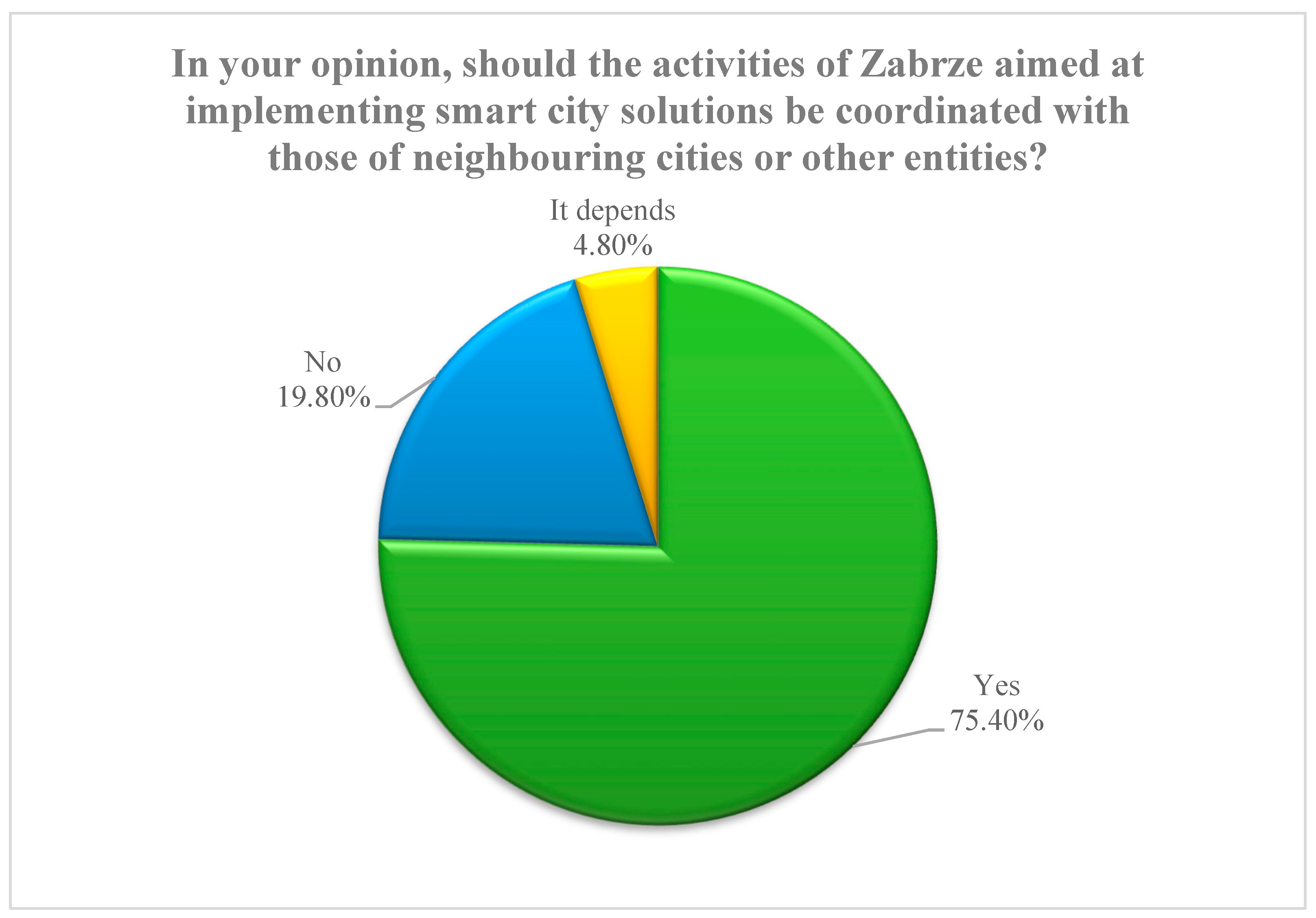1. Introduction
The smart city concept is based on the separation of successive adaptive spheres with the assumption that, at different levels of development of the “intelligence” of urban space, an identical set of stakeholders exists while someone else acts as a leader [
1], from the providers of modern technologies in Smart City 1.0 to the local government in Smart City 2.0 and the residents themselves in Smart City 3.0, and now to the area of modern technological solutions based on artificial intelligence in Smart City 4.0. The implementation of these solutions requires not only the widening of the range of social and economic competencies, especially digital skills but also a certain degree of acceptance of the transformations being introduced, which, in turn, are closely linked to the issue of education, which quantitatively and qualitatively eliminates accessibility limitations and even exclusion. This, therefore, requires an interdisciplinary approach and the involvement of all the stakeholders to cooperate in ensuring that innovative forms of the functioning and development of urban space become a reality [
2,
3]. Analyses of social development indicate “an increasing role for administrative communication and both in the centre and on the ground. This is due to the direct ‘perception’ of administrative decisions by citizens”. In addition to information policy, “the main task is to explain to local and regional public opinion specific decisions and problems that have a bearing on citizens’ lives” [
4]. This also applies to the implementation of smart and sustainable development mechanisms. A smart city requires a concentration of social and economic factors that are key to sustainably increasing the competitiveness of the smart city, which is characterised by an innovative management culture and the sustainable absorption of this culture by its residents [
5]. The technological aspect must also be considered, especially fifth-generation (5G) communication technology, which will pose enormous changes to the creation and deveopment of smart cities [
6]. Notably, we must simultaneously broaden the perspective beyond the technological sphere; the essence of these processes lies in increasing the interactivity and efficiency of urban infrastructure while enhancing the quality of life of citizens. In addition to the typical technical aspects of the operation of cities as systems, social inclusion is an important issue [
7].
A key assumption is the participation of citizens in the implemented changes. Additionally, participation requires the activation of the local community as well as the establishment and maintenance of effective forms of feedback communication with field administration. The challenge of “making the concept of smart cities a reality, particularly in the context of designing and implementing comprehensive (i.e., concerning the economic, social, environmental and spatial spheres), innovative development initiatives” [
8] remains valid. A holistic approach should consider the outlook of the residents, whose perception is directed toward individual elements from the smart city sphere but often does not cover the entire system. During its application, the needs and expectations of the beneficiaries of the smart city should be determined to adapt the implementation process to the absorption capacity while considering the need to avoid risks or high-risk situations. This is why we conducted this described study.
Our aim was to identify the opinions of residents as recipients of activities in the smart city sphere. This will allow the modification of the actions selected to increase their effectiveness. The obtained results indicate the directions for information policy and undertakings that should be implemented by local governments.
Research on smart cities, including the functioning of local administration, has focused on the political [
9], social [
10] and legal [
11] aspects, public–private partnership [
12], civic participation [
13], information management [
14], or reasons for residents’ dissatisfaction [
15]. Studies have covered the use of cyberspace [
16], the Internet of Things [
17], the perception of quality of life [
18], and the development of future generations [
19]. The smart city concept is associated with the participation of residents and the idea of sustainable development [
20]. Smart city and intellectual capital [
21], solving the problems of cities caused by the pandemic [
22], leadership in digital management [
23], or supporting the management of metropolitan areas [
24] were also discussed. The smart city was also discussed in technological and social terms [
25].
3. Results: Residents’ Perceptions of Smart City Implementation Challenges
To determine how the smart city concept is perceived by the city’s residents as stakeholders in the local government unit and the social identification of individual smart growth implementation activities, a study was conducted among Zabrze residents. Zabrze is a city that is part of the first metropolitan area in Poland. Before the political transformation (in 1989), it was a centre of heavy industry. Currently, all the large mines and industrial plants have been liquidated, and the city bases its development on medicine, innovative economy, science, and tourism of the postindustrial heritage created on the basis of industrial facilities.
A questionnaire was prepared containing questions about opinions on the implementation of modern solutions to improve the functioning of the city, increase its competitiveness, and enrich its potential. In addition to obtaining data on the respondents’ views regarding the degree of implementation of innovative technologies, methods, and processes, the need for public consultation, the optimisation of communication tools, and a participatory module were also considered. From the responses, we could determine the residents’ preferences regarding the financial management of local government aimed at meeting the challenges posed by sustainable development.
3.1. Opinions on Smart Cities
Notably, the subject of the smart city was, for the majority of respondents, an issue to which they had paid little attention. Hence, more than 80% of the residents surveyed were unable to provide an example of any solution that would make urban space smart. Only 18% of those surveyed provided the interviewers with a concrete answer to this question, indicating that education and communication activities are a challenge in the process of spreading public awareness of smart growth.
The respondents were also able to share their feelings about the degree of saturation of urban spaces with smart technology in relation to their individual expectations. See
Figure 1. After defining the term “smart city” as a developed urban area where sustainable development is pursued using modern smart technologies, the respondents most frequently (33%) stated that not too many of them had been implemented. This was followed by those marking the answer “far too few”, at 24%. In contrast, almost 10% felt that these solutions were widely available, although less than 2% of the survey participants were convinced that everything possible had already been achieved in the field of smart cities. Others in this group felt that “a lot of them [had been put in place], but we still need more”. Almost 16% of the respondents saw no difference between the situation in Zabrze and that in other Polish cities. Slightly more than 16% of the respondents had no opinion on the matter. Therefore, the social expectation is for increased action to implement smart technologies in the urban space to improve the quality of life of the residents and contribute to sustainable development. The majority of the respondents were unable to identify the discussed solutions already in place in the city.
In application terms, this means for local authorities that the idea of implementing smart city principles as a general project called “Smart City” has a low level of recognition among the population. Therefore, the local self-government community, understood as the electorate exercising the right to elect the bodies of the territorial self-government (constituting: municipal council and executive president, mayor or commune administrator), may not express interest in voting for candidates advocating the implementation of the smart city concept. This is especially true in the case of poorer municipalities, where the implementation of such a programme will require significant financial outlays. The general slogan of subsidising the smart city may lose out to proposals to allocate funds to specific tasks desired by voters, even if these tasks themselves constitute an element of the smart city. The lack of support from the local community may also reduce the level of determination of the local authorities to obtain external non-budgetary funds (regional, metropolitan, national, or EU) for the implementation of comprehensive smart systems, which are not expected by the inhabitants due to a lack of identification of the concept. This requires a high degree of awareness on the part of the local authorities and educational measures.
This also indicates the need to increase communication activities aimed at the social environment among smart technology providers and the need to intensify the activities of municipal services responsible for the distribution of information useful to residents.
3.2. Communication Preferences of Respondents
Considering the aspect of communication activities, the respondents were asked about their preferred media for conveying information. The majority of Zabrze residents declared a willingness to use tools exploiting cyberspace. See
Figure 2. Over 60% of the respondents indicated Internet media, and over 35% chose traditional mass media as the most functional avenue for information delivery. A precise breakdown of the expectations of local government communication included the city hall website (over 23%) and the city’s profile on social networking sites: Facebook (over 18%), Instagram (almost 8%), Twitter (over 6%), and the municipal YouTube channel (almost 5%). Local government press and commercial dailies and magazines were indicated as preferred by almost 18% of the respondents. Similarly, content disseminated via radio and television was preferred by almost 18%.
More than 2% of the respondents said that they did not expect the local administration to inform them about smart city topics, and the rest (more than 1%) indicated other information media.
Given the communication potential of the media available in cyberspace, local governments should focus on ensuring that citizens have access to news about smart city activities precisely through these tools.
3.3. Implementation of Smart City Solutions: Financing, Participation, and Consolidation
The residents’ opinions were also surveyed regarding the funding formula for smart growth implementations. One of the questions regarding participation referred to covering costs with the use of the civic budget, i.e., an amount of spending set aside within the municipal budget that is allocated for initiatives and investment projects submitted directly by the local community and most often concerning their immediate environment. Usually, such projects involve the construction of playgrounds, recreational facilities, enclosures for pets, or neighbourhood car parks. See
Figure 3.The majority of Zabrze residents surveyed (over 64%) approved the possibility of allocating funds from the civic budget to pay for the implementation of smart city solutions selected and accepted by the local community. More than 32% of the respondents were against the idea. The remainder (around 3%) were prepared to conditionally accept the indicated plan but raised additional objections.
The willingness of the majority of the residents surveyed to spend funds directly dedicated to the creation of a friendly urban space on smart city activities convinces us of the validity of the need, mentioned in
Section 3.1, for the local government to intensify its educational and communication activities in the dissemination, popularisation, and promotion of the smart city idea.
The respondents’ perceptions regarding the level of public participation in planning, organising, coordinating, implementing, and supervising all the undertakings related to the development of Zabrze as a smart city were also analysed. We found that the majority (more than 68%) of respondents were in favour of consultation with the residents on every element of such activities. Nearly 26% of the respondents were of the opposite opinion, whereas the others reported that their decision regarding the need for public consultation would be dependent on the conditions of a specific project. Paradoxically, among the participants in the study, the opinion prevailed (nearly 59% of indications) that residents should participate in public consultations on smart city development in person. Additionally, remote participation using digital communication tools was supported by approx. 41% of the respondents. According to the majority of the respondents, these public consultations should be held in the afternoon. This was expressed by more than 63% of the respondents. Slightly more than 30% of the respondents approved of holding meetings (face-to-face or via remote communication tools) with residents in the evening. Only about 6% of the respondents indicated the morning hours as the optimal time for such meetings.
The survey confirmed that residents expect to be treated as partners by the local government. This also applies to the implementation of the smart city concept in social and economic life. The predominant expectation among the respondents to organise meetings in order to participate in consultations in person testifies to well-established participatory habits. At the same time, they represent a challenge for the municipality in the sphere of educational activities presenting remote communication as an effective method of expressing views and presenting the opinions of residents.
Another aim of this survey was to establish the residents’ opinions on the need to consolidate local government units when implementing smart city solutions. See
Figure 4. When asked whether such activities should be coordinated with decisions taken in neighbouring cities or other entities, such as the local government of the Silesian Voivodeship or the Upper Silesian Metropolitan Area, 75% of the residents responded in the affirmative. This is an expression of the social expectation that smart solutions should be implemented in a systemic, coherent, and unified way, allowing people living in different centres forming the Upper Silesian agglomeration to use them effectively. However, almost 20% of the respondents responded negatively to the need for mutual cooperation between individual local government units and the maintenance of relationships with a metropolitan association, intercommunal associations, or voivodeship government. The remainder were not convinced of the need for such cooperation but also did not question its advisability.
The relatively high level of approval for the implementation of smart city activities in agreement and even supra-municipal cooperation testifies to the respondents’ intuitive understanding of the importance of the synergy effect. It also allows forecasting of the positive effects of activities promoting knowledge of the role, principles, functioning, and multi-aspect benefits provided to inhabitants by the smart city.
4. Discussion: Optimisation of Contact between Residents and Local Administration
The results obtained in 2022 were compared with those of the 2021 study to determine the level of the residents’ approval of the implementation of modern technologies in the provision of public services by the local government. In December 2021, a survey of 600 people was conducted on the same study object, i.e., Zabrze. The age structure of the respondents, selected at random, was as follows: under 18 years, approximately 3%; 18 to 35 years, approximately 23%; 36 to 65 years, approximately 56%; and over 65 years, approximately 18%. This means that most respondents were of working age, but one in five respondents fell into the over-65 age category. Regarding their contact preferences with the local government administration, most respondents said that they preferred to deal with official matters during a personal visit to the magistrate’s office (67% of respondents), but approx. 32% clearly preferred the Electronic Platform of Public Administration as a more efficient, easier, and time-saving method [
26]. Thus, every third resident, given a choice, preferred remote contact with the office.
The key issue is, of course, the availability of technology, the awareness of the provided usefulness, adequate competence of the users, and the willingness to engage in the acquisition of knowledge and skills to use the functionalities offered by the technology. In the case of the popularisation of civic activity in the sphere of the smart city, similar to the situation of the implementation of modern communication techniques, the question regarding to what extent people take advantage of the opportunity to be receivers, senders, or creators of these processes remains relevant [
27].
When implementing modern tools for both contact with the local administration and the provision of public services, local government employees must also be aware of the identification of activities related to the smart city idea. The information revealed during another survey conducted in 2021 among the officials of the Zabrze municipality is of cognitive value. The majority of the respondents (79%) declared that the professional tasks they perform concern the practical aspects of implementing the smart city strategy [
28].
5. Conclusions
The residents (80%) could not clearly indicate the currently functioning smart city solutions. However, they expected increased saturation with smart city solutions. In response to the study question, we found that residents need social consultations (68%) and want to be informed about the implementation of smart solutions mainly through online media (60%).
Summarising the technological, functional, social, and economic conditions for the implementation of smart city solutions, and the role of local government units in this process, a decision should be made on the future course of the process. When forecasting the plan for the dissemination of tools in the smart city area, larger urban centres will probably more efficiently and quickly implement such solutions. When making such a hypothesis, it is worth highlighting the potential of larger cities and their personal, economic, organisational, and logistic resources. Larger cities also have more diverse needs, problems, and challenges.
We should take advantage of the increase in the number of remotely provided public services due to the COVID-19 pandemic. To determine the impact of the COVID-19 pandemic on the provision of these services via electronic platforms, a study was carried out on the number of cases submitted to offices in the Upper Silesian Metropolitan Area via a remote system for maintaining relationships between the citizens and the administration called the Electronic Platform of Public Administration Services (Elektroniczna Platforma Usług Administracji Publicznej—ePUAP). The comparison in 2021 covered the cases reported to the 41 local government units forming the Uppersilesian-Zagłębie Metropolis in 2019 and 2020. The larger urban clusters recorded a larger scale of growth of approximately 228%, while the smaller municipalities recorded an increase in the level of e-services of 141%. The smallest municipalities (less than 10,000 residents) achieved the lowest growth in e-services at 123% [
26]. The increase in the number of cases handled via ePUAP was also directly proportional to the income received by the municipalities per number of residents. In the group of municipalities with the lowest incomes, this value oscillated around 150% (148.2%), whereas, in the richest municipalities, it reached 200% (196.9%). Thus, the evolutionary entry of subsequent localities into the realm of particular smart city levels is not, and is unlikely to be, uniform, but, as many years of observations have shown, a postindustrial city, with both its weaknesses (e.g., degradation of nature by heavy industry) and strengths (e.g., creation of a new offer of urban services), can be resident-friendly, attractive from the viewpoint of investments, and open to initiatives that strengthen its potential. Nevertheless, the popular idea of building smart cities requires consistency and responsibility on the part of the local government [
29].
In terms of application, it is worth noting that, as the state of necessity caused by the epidemic caused a radical increase in the number of people using remote techniques for contacting the administration and providing public services, a similar effect may be produced by conscious and planned management of the popularisation of the use of intelligent solutions in economic, social, and political life and the creation of a civil society. It is important, however, not only to raise the awareness of the inhabitants as recipients of this process but also to raise the awareness of the decision-makers and local government officials as well as the management and employees of the units, companies, and institutions dependent on or cooperating with local government.
This implies that local authorities, in addition to the current management of cities, should focus on long-term development. This can be achieved, inter alia, through strategies implementing the assumptions of the smart city concept, an example of which is Smart City Strategy—Zabrze 2030, which was being constructed at the time this manuscript was being prepared. The study results will be considered in its development, which is one of the application values of the completed study.
For local authorities, the introduction of systemic smart city solutions is a process that involves all functions of management, thus initially requiring a planning stage. Then, with a strategy identifying the needs and indicating a formula for achieving the goals, the local authority must undertake organisational activities in order to properly prepare the process of acquiring technologies or equipment and implementing them into the municipality’s functioning. This also requires coordinating the activities of all the units involved in the process (those administered or cooperating with the municipality) and the local community. The next stage is to implement the changes introducing the smart city concepts and then evaluate the effectiveness of the process. Overseeing compliance should also include soliciting data on opportunities for improvement by anchoring product or organisational innovations.
The holistic approach requires a change in the mentality and pragmatics of some officials, who perceive the role of local government only in terms of allocating the necessary funds, preparing a public procurement procedure, controlling the implementation of the investment, settling the project, and appointing the entity responsible for operating the system. In accordance with the conclusions from the described research project, the sphere of responsibility of the local government is much broader. It combines the indicated operational and project activities with the area of social education, information policy, the popularisation of the use of shared technologies or devices, and the promotion of the smart city idea. At the same time, the municipality must not forget about the members of the municipal community who, for various reasons, find themselves in areas of partial or total exclusion (disabilities, economic situation, addictions, helplessness, etc.) and must also dedicate appropriate tools to their needs. An important aspect is also the use of appropriate communication techniques to increase the level of public participation in strategic and tactical decision-making for the municipality and the subsequent implementation of changes. In this way, the municipality, by using modern smart city solutions, strengthens the bonds that form civil society and contributes to the activation and integration of the inhabitants.










